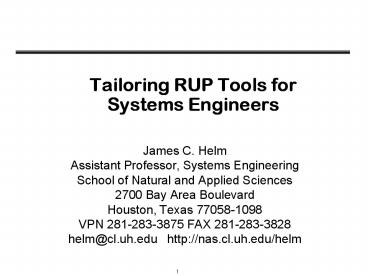James C. Helm PowerPoint PPT Presentation
1 / 20
Title: James C. Helm
1
Tailoring RUP Tools for Systems Engineers
- James C. Helm
- Assistant Professor, Systems Engineering
- School of Natural and Applied Sciences
- 2700 Bay Area Boulevard
- Houston, Texas 77058-1098
- VPN 281-283-3875 FAX 281-283-3828
- helm_at_cl.uh.edu http//nas.cl.uh.edu/helm
2
Overview
- Risk Management Paradigm functions
- Risk Statement by Paradigm function
- Rational Unified Process
- Rational RequisitePro
3
Risk Management Paradigm
4
Components of Risk Management - 1
- Identify
- search for and locate risks before they
- become problems
- Analyze
- convert risk data into useable information
- for determining priorities and making decisions
- Plan
- translate risk information into planning
- decisions and mitigating actions (both present
- and future), and implement those actions
5
Components of Risk Management - 2
- Track
- monitor risk indicators and mitigation actions
- Control
- correct for deviations from the risk mitigation
- plans and decide on future actions
- Communicate Document
- provide information and feedback to the project
- on the risk activities, current risks, and
- emerging risks
6
Components of a Risk Statement
there is a possibility that
Given the
Consequence
will occur
Condition
Risk Statement
- Condition a single phrase that identifies
possible future problems, and describes current
key circumstances, situations, etc. that are
causing concern, doubt, anxiety, or uncertainty - Consequence a single phrase or sentence that
describes the key, negative outcome(s) of the
current conditions
7
IDENTIFY Risk Information Sheet
- Risk Information sheet
- Risk Management database
- Complete
- ID
- Date Identified
- Risk statement
- Origin
- Risk Context
8
ANALYZE Risk Information Sheet
Related areas Priority Probability Impact Timefr
ame Class
9
PLAN Risk Information Sheet
- To be completed
- Assigned to
- Mitigation Strategy
- Contingency plan and trigger
10
TRACK Risk Information Sheet
- Completed or Updated
- Priority
- Probability
- Impact
- Timeframe
- Status
- Status Date
11
CONTROL Risk Information Sheet
- Completed Items
- Approval
- Closing date
- Closing rationale
- Status
12
Rational Unified Process
- RUP is a Software Engineering Process
- A disciplined approach to Project Management,
Assigning Tasks, Responsibilities and
Configuration Control - RUP captures best Software Development practices
- Develop SW iteratively
- Manage requirements
- Use component-Based architecture
- Visually model SW
- Continuously verify SW quality
- Control Changes to SW
13
Rational RequisitePro
- Risk Management is critical for project success.
- Rational RequisitePro provides a common tool for
requirements management that can be applied to
risk management. - Rational RequisitePro provides a framework within
which a risk management project can be created.
14
RequisitePro Tips
- Defining your risk management process
- Deciding on the type of database to store risks
- Deciding how to organize RequisitePro projects
- Creating the RequisitePro project(s)
- Specifying document types
- Specifying risks types
- Specifying risk attributes and default values
- Setup security
- Importing existing risk information into
RequisitePro - Enabling e-mail for discussion groups
- Protecting your risk database
15
RequisitePro Views - RISK
16
Select, Show and Add Risk Properties for the
Project
17
Attributes Matrix Views - RISK
18
Traceability Tree View
19
Summary
- The Risk Information Sheet is key to the success
of the Projects life cycle - The Risk Information Sheet components must be
managed, tracked and controlled - Rational RequisitePro provides a common tool that
can be applied to Risk Management - RequisitePro maintains the Risk Information Sheet
components in a databases (ACCESS, SQL Server or
Oracle)
20
References
- http//tkurtz.grc.nasa.gov/risk/
- http//www.sei.cmu.edu/organization/programs/sepm/
risk - http//www.rational.com/products/proman.jsp
- Dorofee, A. J. Walker, J.A. Alberts, C.J.
Higuera, R. P. Murphy, R. L. Williams, R. C.,
Continuous Risk Management Guidebook,
Pittsburg,Pa. Software Engineering Institute,
Carnegie Mellon University, 1996.

